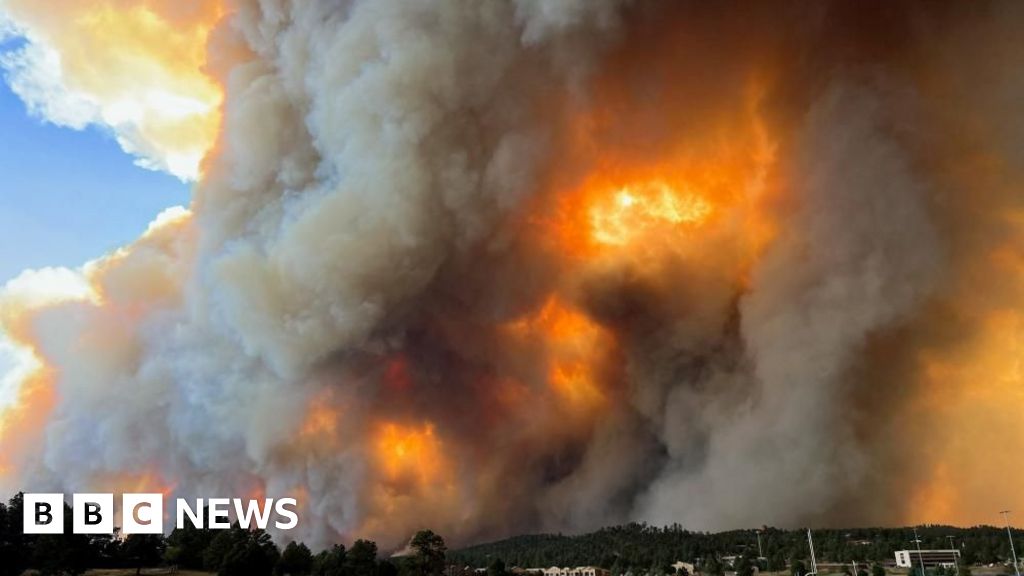A pair of rapidly growing wildfires are converging on a village inside a tribal reservation in New Mexico, prompting thousands to evacuate.
The South Fork Fire, ignited on Monday on Mescalero Apache tribal land, nearly tripled in size overnight, scorching almost 14,000 acres by Tuesday morning.
Another blaze, the Salt Fire, is burning south of the village of Ruidoso and burned nearly 5,000 acres.
Authorities say both fires are 0% contained.
The pair of blazes has semi-encircled the village, officials said. On Monday evening, officials in Ruidoso – home to 7,800 people – urged residents to evacuate immediately.
“GO NOW,” said a note on its website and social media. “Do not attempt to gather belongings or protect your home.”
About 500 structures have been destroyed, said George Ducker with the New Mexico Forestry Division.
“Unfortunately, I think that number is going to be higher,” Mr Ducker told the BBC, adding that officials believe most of the structures lost are homes.
Both fires started on Monday, though the cause for both remains unknown and is under investigation.
Mr Ducker said the fires have grown due to dry conditions and wind, and he expects they will continue to grow throughout the day.
He added it is not clear when residents of Ruidoso will be able to return home.
The fires have prompted the partial closure of US Highway 70 south of the village, and a state of emergency was declared by the president of the Mescalero Apache to aid with evacuation and firefighting efforts.
Phone outages because of the fires have posed a challenge for first responders in Ruidoso, who have had to relocate their emergency operations centre to respond to 911 calls.
Nearby communities have opened shelters for evacuees, and the city of Roswell has cleared hospital space for patients evacuating from the Ruidoso hospital.
Wildfires in New Mexico are not unusual, and the fire forecast this year predicted normal activity, Mr Ducker said.
But because of the ongoing drought in the state, a fire that starts can grow “quick enough that crews can’t contain it”, he said.
Much of the region has been experiencing a drought for nearly a year, and parts of southeast New Mexico are the only in the US to be experiencing what is classified as an “exceptional drought”.
Conditions are expected to remain hot and dry on Tuesday with winds blowing 15 to 20 mph (24 to 32 kilometres per hour).
Officials in Ruidoso said they will be coordinating “massive air attacks” during the day to help douse the flames.
Other crews are on the ground doing “structure protection” work to deter flames from engulfing homes, Mr Ducker said.
While the village is home to thousands, it also attracts tourists to its trails, parks and wilderness due to its proximity to the Lincoln National Forest.
In California, firefighters are battling another wildfire north of Los Angeles, where more than 15,000 acres of land has burned, and hundreds have been forced to evacuate.
The Post Fire is 24% contained as of Tuesday afternoon, according to the Cal Fire website.
The wildfires come as parts of the US grapple with the first heatwave of the season.
More than 70 million Americans, about one in five people, are under heat alerts on Tuesday. Some cities, including Chicago, have surpassed previous record high temperatures for this time of year.
Warnings have also been issued in four Canadian provinces with much of the continent now gripped by the heatwave.
Scientists say extreme weather events are becoming more frequent and intense as a result of human-caused climate change, fuelled by activities like burning fossil fuels and cutting down forests.
Heat waves have become more frequent and more intense globally since 1950, says the UN’s climate body, the Intergovernmental Panel on Climate Change (IPCC).
While wildfires happen naturally in many parts of the world, these heat waves can create conditions that make wildfire spread more likely, the IPCC says, by contributing to longer droughts.

